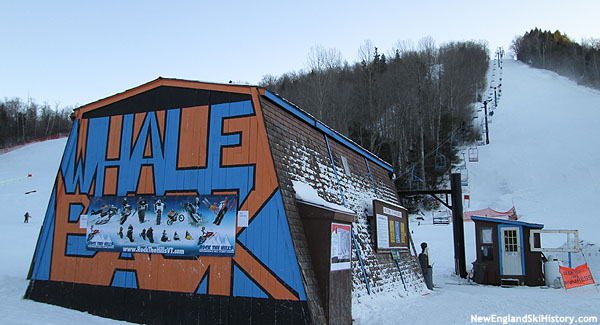
|
|
Located just off Interstate 89 southeast of Lebanon, Whaleback's skiing history dates back to a small operation called Snow Crest.
Snow Crest Ski Area
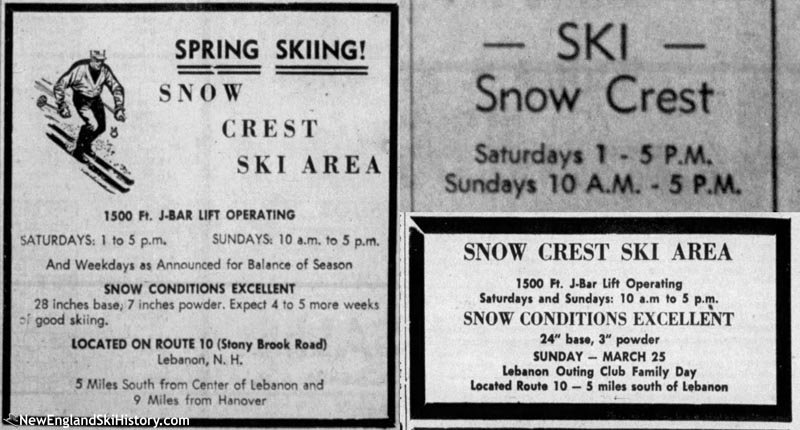
1956 Snow Crest advertisements |
Local ski coach Ernest Dion began development of what would become Whaleback in the 1950s. A Vermont native, Dion won many ski racing and jumping championships across New England in his youth. Dion was set to compete in the 1940 Olympics, however the games were cancelled due to World War II. Though he would continue to compete well into his 50s, his focus shifted to coaching and instructing. In addition to coaching at Dartmouth, Dion helped his sons and nephew to become prominent skiers in the 1950s, being featured in national magazines and television shows. Meanwhile, Dion undertook business ventures in ski equipment and ski area development.
In September 1955, Dion acquired property along the Stony Brook in Enfield from Lyle and Irene Prior. Dion announced the construction of the unnamed ski area in mid-October, adding that the planned expert slope was "better than Suicide Six, to me anyway." In describing the new area, Dion stated that, "everything is ideal there. The slopes, the nearness to town. There are two big parking lots, one right next to the blacktop road, and the other just across a small brook. There will be plenty of room for both the expert and the novice - and for the average skier, too."
Assisting Dion were Kimball Union Academy coach Ira Townsend, Lebanon High School coach Al Merrill, and Arthur Pickering. Though it was not known if the area would open for the 1955-56 season, trail clearing commenced, as well as the installation of a J-Bar.
By January of 1956, the name Snow Crest emerged. It is not known when the area opened, but it hosted the slalom portion of the New England Interscholastic Schoolboy Ski Championships in mid-February. More formal operations commenced in March as Snow Crest advertised an expert trail, a novice trail, and an open slope, plus a ski school directed by Dion. Future plans for "more and wider trails," a rope tow, and a base lodge were advertised. Boston's WBZ-TV visited the area on March 10 to capture footage of the new area.
Snow Crest skiers enjoyed base depths in excess of two feet for the remainder of March. The season extended into the first full weekend of April, albeit with limited parking due to issues with mud.
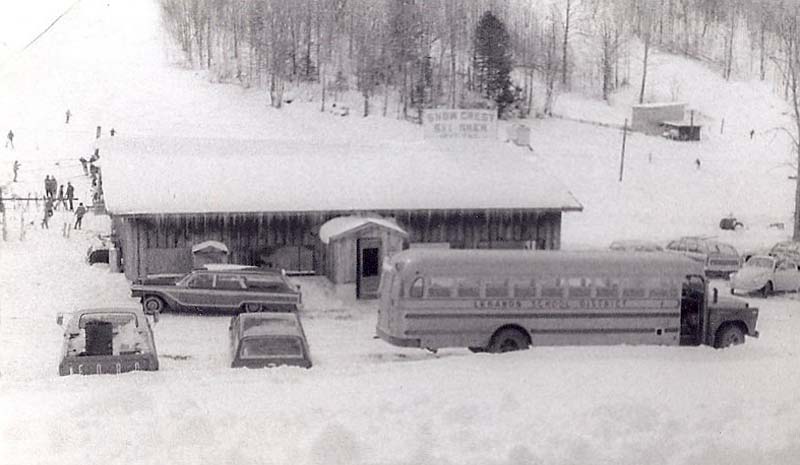
The base area during the Snow Crest days |
Snow Crest was advertised as "new" for the 1956-57 season, adding an intermediate trail and a base lodge (called the "Snow Crest Ski Hut"). The J-Bar was likely retrofitted as a T-Bar, which operated on weekends and holidays. Two rope tows were also initially advertised, but it is unlikely that they were actually installed. The season likely started in early January, but generally only had a few inches of base, likely ending at the start of calendar spring. Following the 1956-57 season, Snow Crest began hosting events at its base lodge.
The 1957-58 season did not get off to a good start, as Dion lacerated his leg while working on the mountain in late November, resulting in a multiple-day hospital stay. Improvements for the season included a new power unit for the T-Bar, a new novice trail, and a rope tow. Dick Wood possibly became involved in the business around this time.
Winter finally arrived in January, with Snow Crest likely opening during the second weekend of the month. Unlike the scant snowpack of the previous winter, January ended with two to three feet of base, growing to nearly four to five feet in mid-February. Popularity of the ski school grew, resulting in Sonny Demers and Raymond Kelley joining Dion's staff.
Skiing continued into April, with the Valley News noting "there wasn't a single bare spot anywhere to be seen" yet "the only disappointing thing about it [was] the lack of crowds." Local children enjoyed a costume contest and torchlight parade, presenting Ernest Dion and Dick Wood with a pair of skis with their names etched. The 1957-58 season continued for one more weekend, wrapping up on April 20.
The first Christmas week skiing at Snow Crest likely occurred with the 1958-59 season. Snowpack wasn't as deep as the latter part of the prior year, but events continued to be held, including the "Snow Crest 600" downhill race in early March. The first race to be held on the expert trail, the Snow Crest 600 was named after event's vertical drop.
In advance of the 1959-60 season, Dion announced that he had purchased the lights from the Alto Ski Tow in Norwich and would be installing them on the slope at Snow Crest. The 1959-60 season likely started on New Year's Eve, with night skiing debuting in early January. Snowpack was minimal until March.
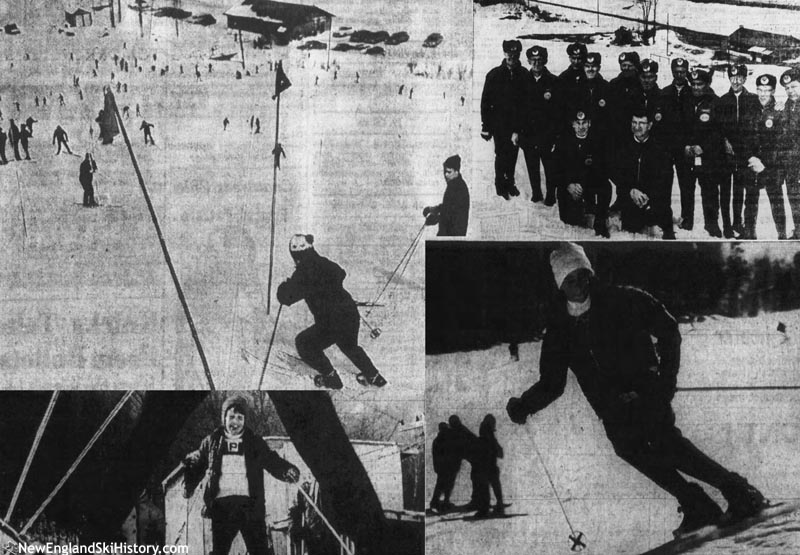
Snow Crest in the 1960s |
The Spout rope tow was to be replaced with a 1,000 foot T-Bar for the 1961-62 season, serving an additional intermediate slope. The season likely kicked off on Christmas Eve, but suffered from poor conditions and minimal snow throughout January. The first race of the winter was not held until February. Meanwhile, work continued on the new T-Bar throughout much of the season, likely debuting on March 10. The 45-day season came to a close on April 1 with a "Fun Day" that included a costumed obstacle race.
Also around this time, Enfield selectmen chose 'Purmort' as the name of the fictional town to be used for a future Interstate 89 exit adjacent to Snow Crest.
Improvements continued with the 1962-63 season, as the base lodge was renovated with new paneling, a fireplace, and a remodeled kitchen. In addition, the summit T-Bar was retrofitted with a larger haul rope and an additional tower at the top. The "new outside trail" was widened, while an additional connector trail was cut. The area transitioned from its weekend and holiday schedule to offering some midweek hours of operation. Though snowpack was once again measured in mere inches instead of feet for much of the season, base depths soared as spring approached. The season likely came to a close at the end of March with business up 15% over the prior year.
Initial plans for the 1963-64 season included a new novice trail and a 60-meter ski jump. Meanwhile, rumors of the area not operated reportedly circulated, resulting in the Valley News declaring, "Contrary to rumors, the Snow Crest Ski Area in Lebanon will be in operation again this season." Skiers were now told to access the area via Interstate 89, still under construction.
Improvements for the 1964-65 season included trail widening, a rental shop, and a ski patrol building. Plans were also announced for the construction of a 90-meter ski jump. The 1964-65 season may have started in mid-December, but was wiped out by a warm, wet Christmas. Though the area had a strong weekend in late January, the season may have fizzled out in late February.
The 1965-66 season may have started with limited operations, vaguely referred to as "economic in nature." Limited midweek operations were added in February.
A group led by Adirondack Timberlock Camps owner Richard Catlin purchased Snow Crest in December of 1967, with Dion holding the mortgage. Dion later told the Valley News that he sold Snow Crest because he was working "eight days a week." Featuring a new snowcat, the 1967-68 season likely started just before New Year's. By early March, Snow Crest reported that business was up 30%.
On November 25, 1968, the stretch of Interstate 89 between New London and Grantham opened, marking the completion of the New Hampshire section of the highway. In December of 1968, Catlin established Whaleback Mt., Inc., and transferred the ski area to the corporation. Partners in the company may have included brothers Jim and Clark Griffiths, Bayne Stevenson, and W. Myric Wood Jr. Additional land may have been acquired around this time, including above the existing T-Bar. Improvements for the 1968-69 season included new picnic tables in the cafeteria and a large picture window facing the slopes. The season likely started just before Christmas. Catlin told the Valley News, "We know our lifts are out dated, but we still have a lot of good skiing to offer." Unfortunately for the group, the operation "lost a lot of money" that season.
First Closure
In October 1969, Richard Catlin and Clark Griffiths placed ads in the Valley News listing the ski area for sale or lease. By November, word emerged that Snow Crest would not open that winter. Locals reacted quickly that fall, focusing on reestablishing downhill skiing at Storrs Hill. Jim Griffiths, a young English teacher at Thetford Academy, eventually became controlling owner.
Snow Crest Reopened, Renamed
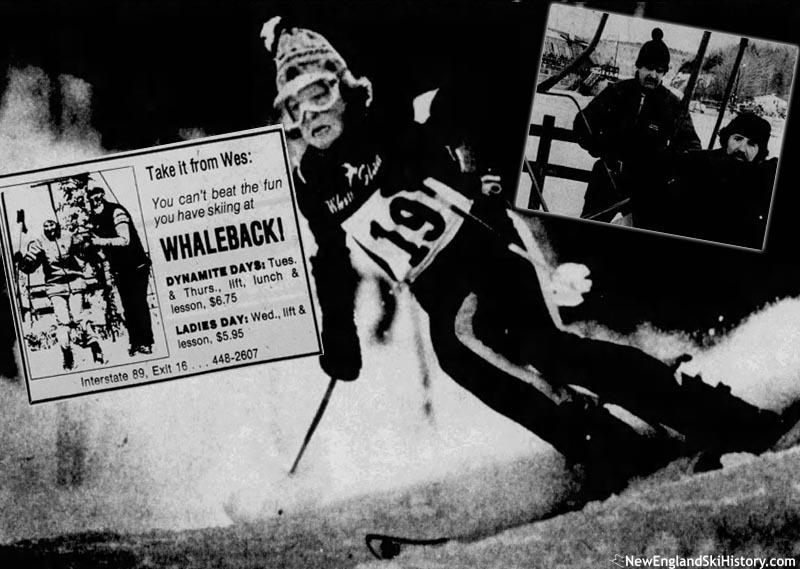
1970s at Whaleback |
After sitting idle for a season, Snow Crest reopened for the 1970-71 season with a new 2,520 foot long, diesel-powered Heron Poma double chairlift. Replacing the original T-Bar lift, the new chair served new upper mountain trails. Night skiing continued to be served by the lower mountain T-Bar. The ski area was formally renamed Whaleback for the 1971-72 season. Meanwhile, Ernest Dion drove the redevelopment of nearby Storrs Hill.
A new lounge ("Spouter Lounge") and sundeck were advertised for the 1972-73 season.
The intermediate Fluke trail was added for the 1973-74 season, bulldozed by Griffiths. Roughly ten months passed between lift served turns, due to the early end of the 1972-73 season and late start to 1973-74. Due to energy concerns, the operation of the T-Bar was reportedly minimized, as Jim Griffiths told the Valley News it was "one very old and tired T-Bar." The struggles continued, as rain and minimal snow shut down the ski area from late January until the second weekend of February. Rain washed out skiing again at the end of Washington's Birthday week. A snow storm arrived at the start of calendar spring, but was one again followed by rain. The largest snowfall of the season for Whaleback happened after Easter, too late to rescue the poor winter. According to the Valley News, Griffiths blamed the poor weather on nuclear testing.
Energy continued to be a concern for Griffiths, as he was concerned that fuel prices could threaten interstate travel, telling the Valley News that "I would guess that when this chair lift has served its predicted life...Twenty, maybe twenty-five years...We're not going to have any more use for it." Nevertheless, Griffiths was still bullish enough to start planning for a new novice slope and Poma lift.
Business started rebound with the 1974-75 and 1975-76 seasons, with Griffiths noting, "People started coming out again." The 1976-77 season didn't have "that much volume of snow, but the timing has been good and the temperatures have been cold enough to preserve," with Griffiths adding, "It's been very tiring but very lucrative." Good snowfall in 1977-78 result in a record season.
Following the season, Whaleback made headlines with its appeal to stop real estate taxation on its chairlift, arguing that it should be considered machinery.
A lower mountain Poma lift was likely installed for either the 1977-78 or 1979-80 season, serving Blubber and Lower Ivory Run.
The 1979-80 season was a disaster for Whaleback, as it may have operated for only three days. Griffiths reportedly sold 60 acres of land to cover bills.
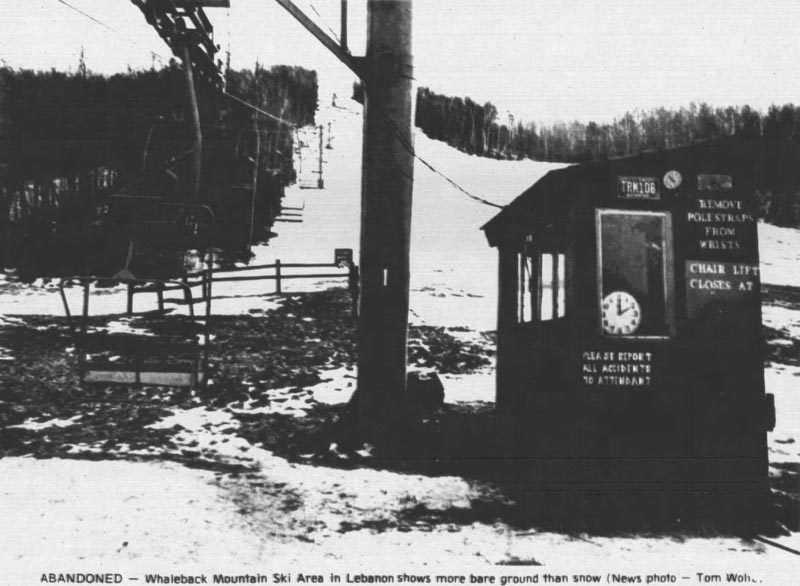
An idle Whaleback in February 1981 |
The 1980-81 season likely kicked off in time for Christmas week, but Griffiths described the situation as, "You've got ice, you've got beautiful packed powder, you've got bare spots, you've got rocks." A few days later, warm rain descended on the area, leaving Griffiths to remark, "Our base lodge looked like a steamship heading south." The area struggled to open trails or draw crowds and was washed out by an early February rain storm and likely remained closed until a storm at the very end of the month. The season likely lasted until late March, operating a total of 65 days. Griffiths told the Valley News that he was considering either developing a plan to install snowmaking or else to break up the property.
December 1981 started off with multiple storms, allowing Whaleback to open before Christmas and run advertisements proclaiming "Winter is Back." A near-capacity crowd over the Christmas holiday weekend resulted in Whaleback's best numbers in three years. The momentum continued through Washington's Birthday weekend, when the area nearly reached its 800 ticket capacity. Griffiths commented that, "The skiing has been just fabulous. There are some scratchy parts where the trails are steepest, but you have to expect that where you don't make snow." The strong season extended into April.
The weather struggles returned with 1982-83, when the season did not get underway until the second half of January and likely didn't make it out of the first week of March, operating a total of 35 days.
The 1983-84 season also likely didn't get underway until January. The area was slammed with rain and warm weather as Washington's Birthday weekend arrived, washing out the last chance at making significant money. Spring skiing did, however, last into the start of April.
Citing a 40 year ski jumping career and his development work in the industry, founder Ernest Dion was inducted into the National Ski Hall of Fame in 1984. Dion told the Valley News, "I've given most of my life to skiing, but I've loved doing it, too."
Griffiths Sells
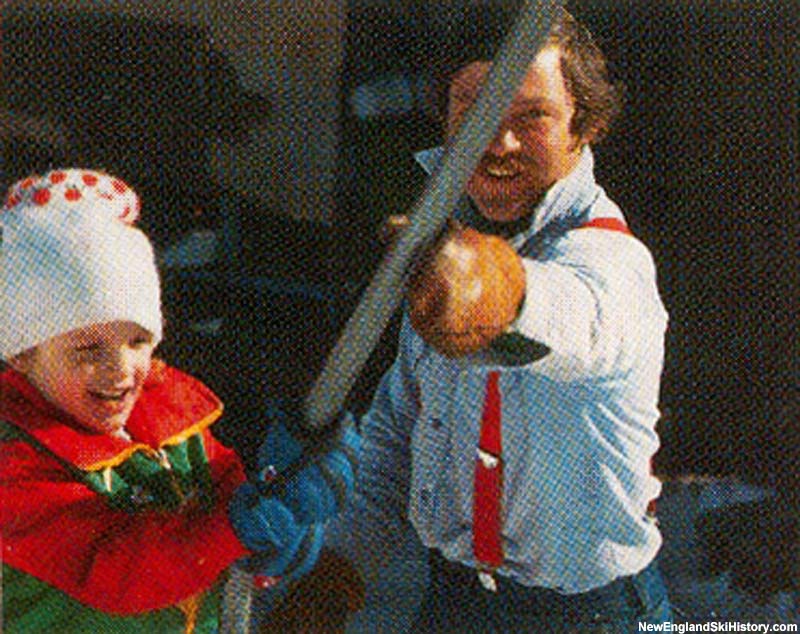
The Poma lift during the 1980s |
In August 1984, Thomas Kent, David Clark, and Jeffrey Reed's Hephaestus Corporation entered into a purchase and sale agreement to acquire Whaleback. Primarily in the construction business, the partners were Dartmouth College graduates. The ski area had been on the market for three years, as Griffiths had "carried the ski area as far as I wanted to carry it." In November, Hephaestus Corporation purchased all outstanding shares of Whaleback Mt., Inc. from James and Martha Griffiths, who issued the group a $700,000 mortgage.
The new ownership group installed snowmaking for the 1984-85 season, while also planning for new trails and lifts and expanded snowmaking and night skiing. Jeff Reed served as general manager, while Gerd Riess served as ski school director.
Back to back early season snowstorms allowed the new owners to open on natural snow in early December 1984 while the snowmaking system was still being installed. The specs of the diesel-powered Larchmont system included a 250,000 gallon pond and 15,000 feet of snowmaking pipe installed by the Hephaestus Corporation's crew. The system was put into use just before Christmas. Thanks to snowmaking, Whaleback managed to operate 82 days during an otherwise subpar season, which likely came to a close after the first weekend of calendar spring.
In the fall of 1985, the Orca Corporation was formed by David Clark, Tom Kent, and, Jeff Reed, as well as a new partner, Leo Rabinovitz, for the purpose of operating the ski area. Rabinovitz's focus was "aggressively marketing Whaleback." The property was transferred to Stoney Brook Trust in December 1985.
Night skiing was added for the 1985-86 season, powered by 400-watt halide lights. Lit trails included Upper and Lower Whaleback, Spout, and Blubber, as well as the new Ambergris. The price for the day season pass was increased by 10%, while a full pass including night skiing was 50% more than the previous year.
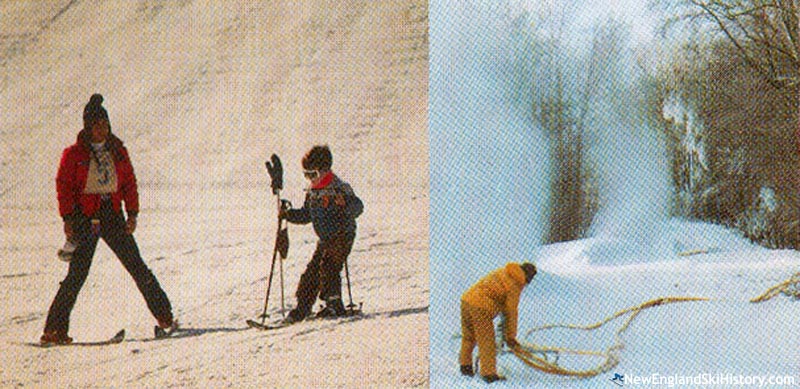
The 1980s at Whaleback |
In addition to the night skiing project, the base lodge was renovated and a 3,000 square foot deck was constructed over Stony Brook. A new ski shop and rental facility was also constructed, while a ski touring trail beyond Ivory Run was advertised. New innovations included "Wally's Whale Watch" ("so you can combined washday with a day of skiing"), a "Slidewalk Cafe" ("the first on-skis fast food bar"), and the "Whale-Watch" ("an action packed big screen video playback of your day on the slopes"). Jeff Reed summarized the changes as being made "to attract more skiers, and to make Whaleback a self-sustaining, viable business enterprise," the success of which "will dictate future plans" to "expand Whaleback into a regional recreational facility encompassing skiing, skating, and cross country skiing."
Whaleback's night skiing installation was dedicated by Governor John Sununu on December 13, 1985. Though a lack of snowmaking temperatures and a focus on the construction projects prevented the area from operating that night, the ski season may have started a day or two later. The area limped through Christmas week with thin cover.
January started off well with a modest snow storm, but experienced a wet thaw a couple of weeks later, wiping out most trails for the rest of the month. Snowmaking and a few smaller snowfalls allowed Whaleback to open all of its trails by the second weekend of February. Whaleback nearly set a record on the Sunday before President's Day with 700 skiers. By that point, season-to-date revenue was higher than the total for 1984-85.
Whaleback held a pre-season open house in September to drum up season pass sales with hay races, movies, and a hang glider demo. Unfortunately, a hang gliding participant was hospitalized after a crash.
Chris Ellms took over as general manager for the 1986-87 season. A native of Enfield, the 29-year-old Ellms had worked as a mountain climbing guide and then for Whaleback's parent company Hephaestus. Changes for the season included widening congested areas of trails, improving the kitchen and ski shop, and eliminating weekday mornings due to lack of business. Ellms told the Valley News that "We don't look upon ourselves as a 'destination resort' and never will. We're very much a local ski area, catering to local people."
Whaleback made waves that fall when it briefly fired up snowmaking on November 5. Though there was some talk of potentially operating that month, the season likely did not kick off until the weekend before Christmas, when a foot of powder opened up all of Whaleback's trails. Multiple January snow storms further boosted business.
By early February 1987, Whaleback had broken "records all over the place," already nearly surpassing prior year revenue. Chris Ellms told the Valley News, "After a year like this, you start thinking about more improvements."
In March 1987, Whaleback hosted the Ford Sayre Ski Carnival, which drew more than 275 skiers. The season came to a close on March 22, with Chris Ellms attributing some of the success to night skiing "starting to catch on."
Proposed Real Estate Development and Expansion
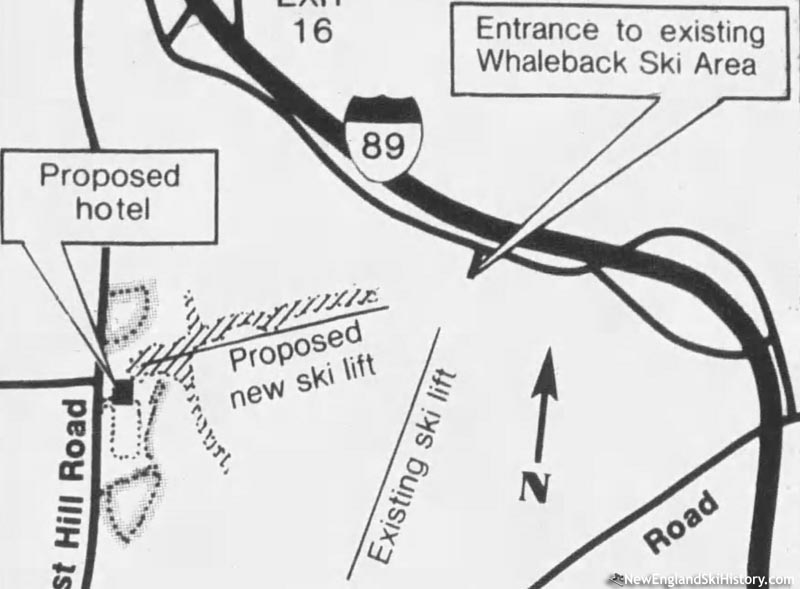
The proposed real estate expansion |
In September 1987, Stoney Brook Trust agreed to sell a tract of land (including some of the ski area) to Richard Bueschel and Peter Jordan (later under the name of Methodist Hill Properties) for $730,000. In December, word emerged that Bueschel and Jordan were planning a $40 million condominium and hotel development tied in with the ski area. The six-year plan called for 264 condominiums located near Ivory Run, a 100-room hotel at the height of land on Methodist Hill Road, new trails, and a new chairlift from the base of the ski area to the hotel. Meanwhile, an agreement was reportedly made to give the developers a 40% stake in Stoney Brook Trust and Orca Corporation and first right of refusal, pending town approvals for the development.
The 1987-88 season likely kicked off just before Christmas, but had more to contend with than a mid-season thaw. On December 31, Whaleback's liability insurance policy expired. Despite having only one claim, the area's insurance premiums had reportedly doubled since 1984, representing 12% of Whaleback's lift and rental revenue. Word of the issues emerged in February, when Whaleback announced it would close to the public at the end of the month. Chris Ellms told the Valley News that "Somehow, we will figure out a solution to this problem and reduce the cost to Whaleback and New Hampshire ski areas by next season."
Closed to the public for skiing in March 1988, Whaleback held a Sno-Prix sledding event at the end of the winter, drawing 50 participants.
In April, owners David Clark, Tom Kent, and, Jeffrey Reed mortgaged Stony Brook and Orca's holdings to pay off $300,000 in debt owed by Hephaestus Corporation, which was being dissolved. Meanwhile, the planned real estate was stalled by the town.
In addition to weddings, Whaleback continued to host a volleyball league during the 1988 off-season. In late May, rock band Molly Hatchet played at the area.
In October 1988, Richard Bueschel and Peter Jordan sued Whaleback's ownership group, attempting to force the ski area into receivership. In early November, Tom Kent became sole owner of the ski area.
A new intermediate trail was added for the 1988-89 season, reportedly initially named "Jonah's Escape." In addition, a new beginner slope and surface lift may have been added. Meanwhile, Whaleback found a new insurer which reportedly provided coverage with one half the premium of the previous company.
The 1988-89 season had a lean start on manmade snow with only 2 to 3 trails open during Christmas week. By mid-January, Whaleback had already exceeded the prior season's snowmaking hours, but only had 3 to 4 open trails to show for it, with Chris Ellms telling the Valley News, "It was an expensive sprint to get to this point." By the time February vacation week arrived, visitation and revenue was significantly behind the 1987-88 season. The season likely came to a close in mid-March.
Following the 1988-89 season, Chris Ellms departed to become general manager of Ragged Mountain. Owner Tom Kent took on the role of general manager at Whaleback. Further improvements were made in the snowmaking system for the 1989-90 season.
Second Closure
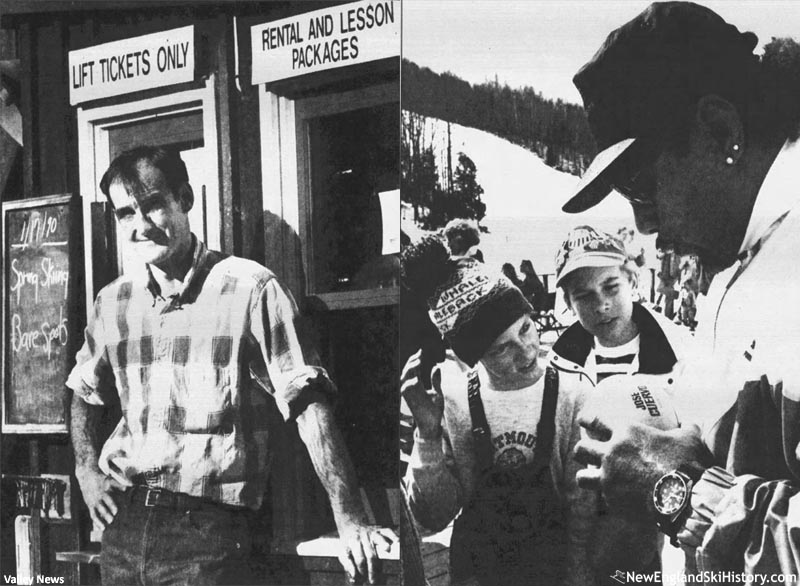
Owner Tom Kent (left) and Patriots star Mosi Tatupu at Whaleback in 1990 |
The 1989-90 season was a struggle, as warm weather and minimal snowfall negatively impacted the already strapped ski area. Tom Kent muttered to a Valley News reporter in January, "Stupid climate. Stupid Greenhouse Effect," adding, "This winter is a bad winter." Kent concluded, "This area needs a little more capital, a little more snowmaking. Every trail should be lit. But this ski area has character. It's a time of change in the industry, but I think Whaleback will be here in 10 years."
Unfortunately for Whaleback, what started as a $500,000 loan from First Twin-State Bank in 1987 escalated to $860,000 by the start of 1989-90. Another note was issued in January 1990, reportedly pushing the debt over $900,000. Pressed for cash, Kent entered into a contract to sell advertising space on chairlift chairs, telling the Boston Globe, "We're stuck in a tough spot. It costs a lot to run the place, but there's only so much you can ask your customers to pay."
In March 1990, Whaleback hosted a Winterfest Weekend fundraiser for the United States Disabled Ski Team. New England Patriots running back Mosi Tatupu headlined the event, suggesting he might try skiing once he retired from football.
As winter came to a close, Kent found himself in hot water with his peers when he told the Valley News, "It's difficult to compete with Dartmouth College and the Rockefellers. The fact is that both of those ski areas are losers. They could not stand on their own." Kent also blamed "problems of bad management over the last few years" for Whaleback's unpaid bills. Kent added, "The only thing we could hope to do was to be alive at the end of this season and we did that."
In May 1990, Whaleback was officially put on the market, as Kent wanted to focus on his other business. Listed $1.3 million, the property included 160 acres of land, as well as the associated equipment. The price was subsequently dropped to $1 million, but a buyer could not be found.
In November 1990, First Twin-State Bank announced it was foreclosing on its mortgage with Stoney Brook Trust, scheduling an auction with Sanders & Mock Associates for December 18. The bank had four potential suitors and expressed that it did not want the area to sit idle. However, when the auction only drew two low bids, the bank acquired the property for $575,000.
Whaleback sat idle during the winter of 1990-91. In September 1991, First Twin-State Bank merged with two other banks to become Green Mountain Bank. The bank was reportedly listing the ski area for $450,000.
Circa November 1991, a company called Whaleback Enterprises Inc. attempted to negotiate a lease for the 1991-92 ski season. However, discussions with the unnamed Boston investor fell through and Whaleback sat idle again during the winter of 1991-92.
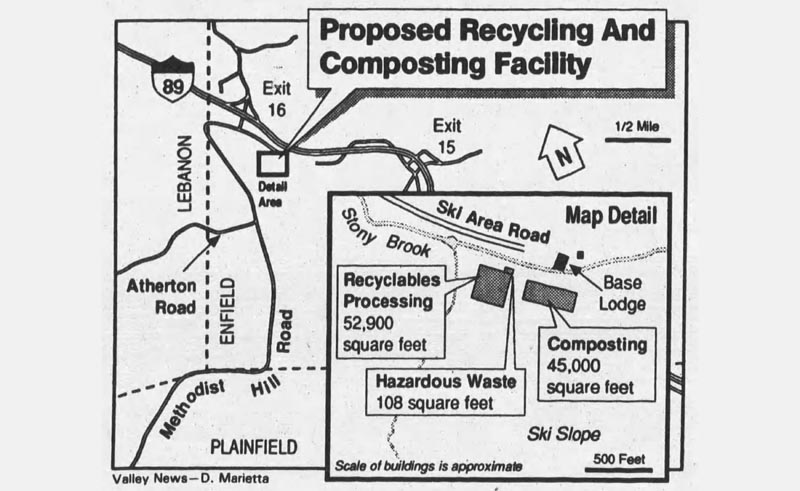
The proposed recycling and composting facility |
In April 1992, a $10 million composting and recycling facility was proposed by Robert Kelly. Three buildings were to be constructed across the base area, while the existing lodge would become a visitor center. Kelly noted that his group would be open to allowing skiing on the remaining property if an operator stepped forward and relocated the chairlift. The proposal was rejected by the Enfield Zoning Board of Appeals in June, which found the base area to be wetlands.
Saved Again
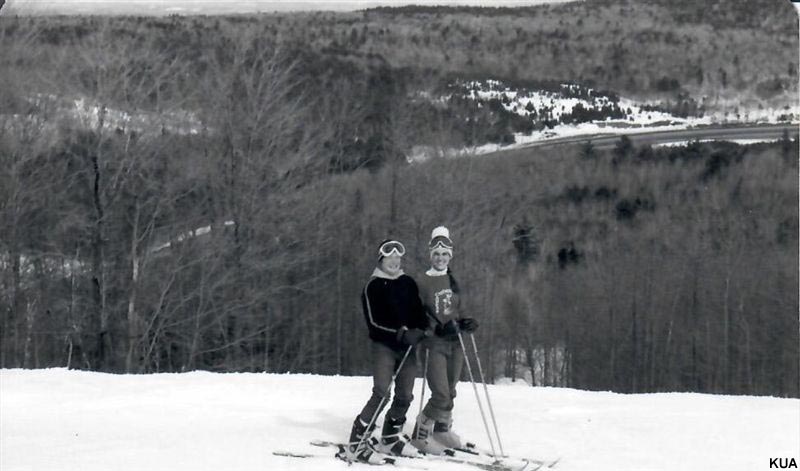
Tim and Sally Herbert |
As Whaleback sat idle for a third consecutive winter, a group led by Tim and Sarah "Sally" Herbert signed a purchase and sale agreement for the area. Both Kimball Union Academy graduates, Sally was well acquainted with the area, as her father was former Whaleback owner Jim Griffiths.
In April 1993, the Herberts' Ski Whaleback Ltd. completed its purchase of Whaleback from Green Mountain Bank for a reported $280,000. The couple owned 50.5% of the company, while four family members owned the rest. Instead of trying to compete for the population centers down south, the young couple made a conscious effort to keep advertising local to save money. Apart from mowing the brush on the trails, getting the equipment functional (including installing new communication and safety equipment on the chairlift), and replacing the lodge deck, no major changes were made in advance of the 1993-94 reopening season. The Herberts based their business plan on a snowless winter.
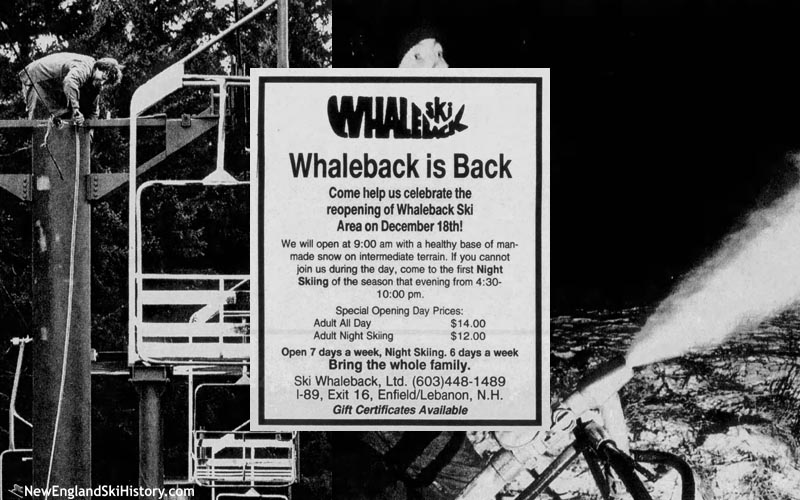
Whaleback reopens (1993) |
After three years of closure, Whaleback opened on one manmade trail on December 18, 1993, offering day and night skiing at discounted prices. Skiing remained limited to one trail throughout the holiday season, however January snow quickly opened the rest of the mountain. February and March were reportedly strong.
Whaleback kicked off its 1994-95 season in mid-December, but limped through the holiday season with only two trails open. Warm January rain wiped out much of the snowpack, leaving Tim Herbert to lament, "At some point, you've just got to realize that no matter what you do, it's not going to matter. It certainly hurts, but what are you going to do?" The area was closed for nearly two weeks before making enough snow to reopen with one trail at the end of the month, offering $5 tickets. An early February storm rescued the season from doom, but March was still a struggle with only a few trails open. At one point, Whaleback offered a 25 cents per run promotion to attract more skiers. The season came to a close in mid-March.
Investments for the 1995-96 season included snowmaking improvements, a half pipe, a terrain park, and a new nursery. The season kicked off in mid-December once again, but with better weather, resulting in the trail count rising to 18 by Christmas week. January enjoyed a strong start with a snowstorm, however rain arrived later in the month. March had natural snowfall, likely keeping the area open into calendar spring.
Four glades were cut for the 1996-97 season. The season started a few days before Christmas and limped through the holiday week with only one or two trails open. Terrain remained limited until mid-January. Whaleback was the beneficiary of large storm later in the month that finally opened all of its trails. Interviewed by the Boston Globe, Tim Herbert summarized the area as, "All people see is that one steep slope. There's a lot more here than that," adding Whaleback is, "Attractive and affordable. We'll be the feeder mountain and the place where people get started. That's where we make our money." The season likely ended around the start of calendar spring. Skier visits and revenue were both up 6 percent over the previous season.
Beyond the typical weddings, Whaleback hosted multiple off-season events during the 1997 off-season, including motorcycle hill climbs, concerts, and the Roberts Bros. Circus. Further diversification took place with adding snow tubing for the 1997-98 season, served by a handle tow.
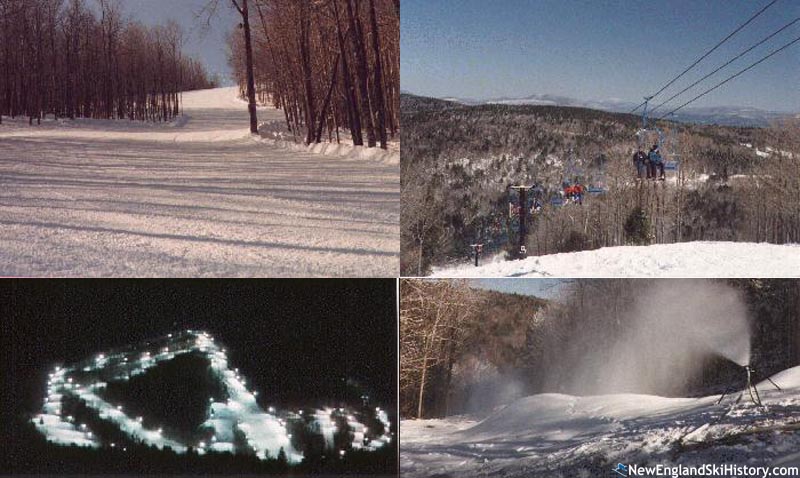
Whaleback in the 1990s |
Snowmaking for the 1997-98 season started on November 12, as Tim Herbert stated, "We are aware that El Nino is around and, of course, are making plans accordingly. Although I'm an optimist, I still have to assume that the winter will be poor and plan snowmaking around it." The season started a month later on manmade snow, with natural snow pushing it to 100% open before the end of December. Rain and a devastating ice storm quickly knocked the ski area down to only a couple of open trails. The ice storm took down 400 trees, resulting in a slow recovery due to the need to use hand tools to remove the debris. Glades were reportedly heavily damaged, with Tim Herbert telling the Boston Globe, "some of our glades will probably now be regular trails, which is too bad because we got them just a couple of years ago." The season eventually rebounded, running through the end of March.
To help bolster season pass sales for the 1998-99 season, Whaleback arranged to get passholders one free day each to Black Mountain, Dartmouth Skiway, King Pine, Pats Peak, and Tenney Mountain. An arrangement was also reportedly made with nearby Eastman. Improvements included converting the double chairlift from diesel to electric and expanding the base lodge by 15,000 square feet.
The 1998-99 season commenced during Christmas week with limited terrain. Natural snow arrived in January, allowing for Whaleback to be 100% open throughout February and to extend the season through the end of March.
Founder Ernest Dion passed away on March 26, 1999 at the age of 82. Jim Griffiths told the Valley News, "He worked tirelessly and selflessly for the sport of skiing and ski jumping. He never earned a dime off it. Fortunately, he had a day job and didn't have to support himself from skiing. He did it for the kids."
The Herberts' Ski Whaleback Ltd. acquired 8.6 acres of land near the base area from Griffiths in 1999 for $235,000. The 1999-00 season kicked off for Christmas week with one manmade trail open. Warm weather and rain did not help matters, but tubing still reportedly fared well during the holiday period. The first snow storm of the season didn't arrive until late January.
Night skiing received increased focus for the 2000-01 season, as three more trails were lit. A new "Night Shift" program was launched, allowing participants who purchased a $49.99 early season membership the ability to buy half price night skiing lift tickets. A double diamond trail was also cut, named YOOYM ("You're Out Of Your Mind"). The season ran from mid-December to late March.
Third Closure
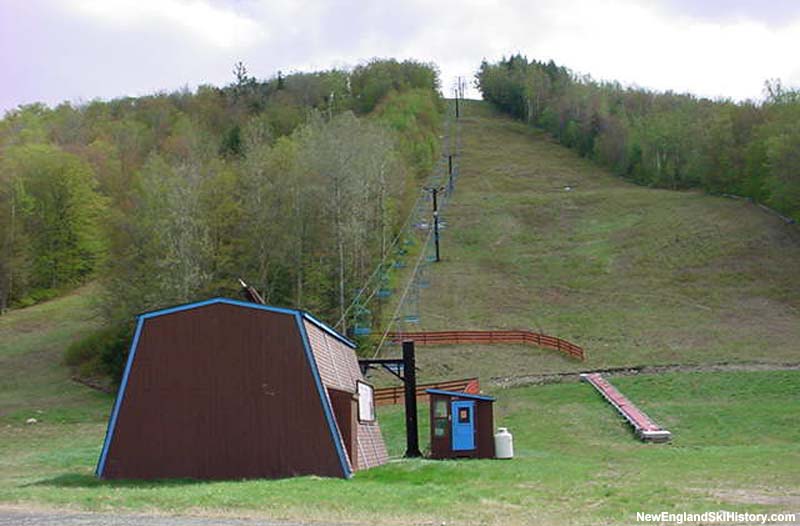
An idle Whaleback during its third closure (2002) |
In May, the Herberts announced that despite Whaleback having its busiest season yet, the ski area still lost money due to the labor market and rising fuel prices. As a result, the Herberts shut down Whaleback and put it on the market. Tim Herbert told the Valley News, "I still believe the place can make it. It's just that I'm not able to make it any more." A few years later, Herbert added, "We had a couple of bad winters, but that wasn't really the problem. For us, really, it was not enough numbers through the door."
Though there was hope that the area could be sold in time for the 2001-02 season, Whaleback sat idle.
2005 Reopening
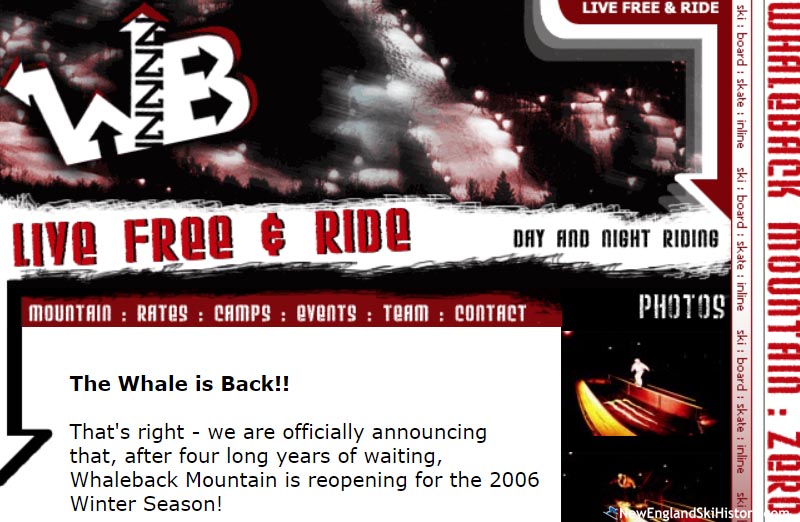
The 2005-06 reopening |
After multiple years of dormancy and offers to convert the ski area to a real estate development or religious retreat, word of a potential deal to reopen the ski area began to circulate in December 2004. Twenty-nine-year-old two-time Olympian Evan Dybvig announced plans to purchase the area and construct a 30,000 square foot gym to transform Whaleback into a year-round freestyle facility. Dybvig had reportedly spent five years trying to convince an existing ski area to host such a program before settling on buying Whaleback. Tim Herbert told the Valley News, "We love the place; it's a very special mountain. We were hoping we'd eventually find someone with a good plan who wanted to run it, and along came Evan."
By the end of June 2005, Dybvig had assembled a group of investors, including his father Richard Dybvig and Frank Sparrow of Rutland's Zero Gravity skate park. Dylan Goodspeed, co-owner of Zero Gravity, was also reportedly involved. Though the original plan called for a $2 million investment, a lack of capital resulted in plans being scaled back significantly. Dybvig told the Valley News, "It was too risky a proposition," noting the scaled back concept would "prove our business plan and get some cash flow." A bridge loan was obtained from Randolph National Bank.
Named Whaleback Mountain LLC, the new group completed the purchase on September 7, 2005, with the Herberts' Ski Whaleback Ltd. holding a mortgage. Dybvig told the Valley News, "The absolute priority is our snowmaking system and our chairlifts [sic]. Not far behind that is the night lights for night skiing and the indoor facility." The Rutland Zero Gravity skate park was shut down so that the equipment could be relocated to Whaleback. Meanwhile, plans were made to construct a Verizon communications tower near the top of the ski area.
Natural snow hit during the first full week of December, slowing preparations for the reopening. Evan Dybvig told the Valley News, "It's totally killing us. We've had great snowmaking conditions and now we've got great natural conditions, but we've got a lot to do before we can get going."
After sitting idle for four seasons, Whaleback reopened on the day after Christmas in 2005 on manmade snow with three trails.
Year round activities were subsequently developed, including paintball, summer jibbing, and bike camps.
Back to the Auction Block
In March of 2013, owner Evan Dybvig announced that the ownership was over $1 million in debt and would be forced to liquidate the ski area. An auction occurred on August 1, 2013, at which mortgage holder Randolph National Bank placed the only bid, purchasing the area for $848,000.
Upper Valley Snow Sports Foundation Takes Over
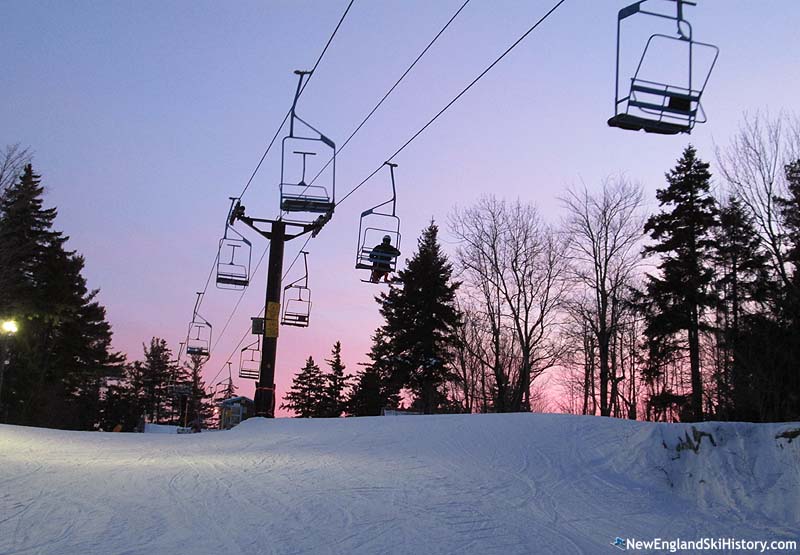
The double chairlift at night (2014) |
Meanwhile, John Schiffman created Upper Valley Snow Sports Foundation as a New Hampshire Non-Profit Corporation on June 3, 2013. The organization signed a lease and purchase agreement with the bank in mid-September 2013 and took control of Whaleback in November 2013. An initial $100,000 fundraising campaign was executed in two weeks time, generating enough money to get the ski area up and running for the 2013-2014 season. Last minute base area work, such as a new kitchen, septic system, and well, was conducted to get the facility back up to code. Using some equipment purchased from Balsams Wilderness, Whaleback was able to fire up its snowmaking system and reopen in December 2013.
After a successful 2013-14 season, Whaleback struggled to get out of the gate during mild weather at the start of the 2014-15 season. Though it was unable to open until mid January, Whaleback was able to attain its latest closing day in recent memory, wrapping up operations the last weekend of March.
Following a bad 2015-16 season in which Whaleback was only open for 50 days, the UVSSF completed a fundraiser to reconfigure the mountain's novice area. One year later, a refurbished T-Bar was installed between the two beginner lifts, roughly following the lift line of the former Pomalift.
NewEnglandSkiConditions.com Reports
| Month |
Average Percent of Terrain Open |
| December | 29% (5 reports) |  | | January | 44% (7 reports) |  | | February | 61% (6 reports) |  | | March | 94% (8 reports) |  |
|
| Recent Conditions Reports |
 | Feb. 9, 2025 by indyskier29
Powder, Powder |
 | Mar. 12, 2023 by brianna
Loose Granular, Spring Snow |
 | Mar. 12, 2023 by rocket21
Packed Powder, Spring Snow |
 | Jan. 26, 2020 by nhalex
Spring Snow, Variable Conditions |
 | Mar. 12, 2019 by rocket21
Packed Powder, Packed Powder |
|
|
| Whaleback Mountain on NewEnglandSkiConditions.com |
Expansion History
| Project |
Season |
 | Methodist Hill
Cancelled | 1980s | |  | Upper Mountain
Open | 1970-71 | |
NewEnglandSkiIndustry.com News
| Recent Articles |
| Whaleback to Start Season Without Chairlift - Sep. 19, 2025 | | Whaleback Seeking Donations to Repair Chairlift - Mar. 13, 2025 | | Whaleback Season to End Early Due to Lift Issue - Mar. 5, 2020 | | Upper Valley Ski Areas Struggling - Jan. 19, 2020 | | Chairlift Chatter - Jan. 8, 2020 | | Lodge Construction in Progress Across New England - Oct. 16, 2019 | | Multi-Year Lift Installations: The New Norm? - Aug. 4, 2018 | | Management Changes Announced at Whaleback - Jan. 23, 2018 | | Lift Construction Season Enters Final Phase - Oct. 29, 2017 | | Whaleback Postpones T-Bar Installation - Dec. 7, 2016 | | Whaleback Mountain NewEnglandSkiIndustry.com News Page |
Image Gallery
Lifts
Click on lift name for information and photos
Maps
Year by Year History
Adult Weekend Full Day Lift Ticket; Adult Full Price Unlimited Season Pass. Window price, including RFID fee and taxes when known.
| 2020s |
Ticket Price |
Season Pass Price |
Pass Payback |
Opening Day |
Closing Day |
Skier Visits |
| 2024-25 | $50.00 |  | $299.00 |  | 6.0 days | December 21 | March 9 | |  | | | 2023-24 | $50.00 |  | $275.00 |  | 5.5 days | December 26 | March 10 | |  | | | 2022-23 | $50.00 |  | $275.00 |  | 5.5 days | December 26 | March 26 | |  | | | 2021-22 | $50.00 |  | $250.00 |  | 5.0 days | December 26 | March 18 | |  | | | 2020-21 | $45.00 |  | |  | | December 23 | March 21 | |  | | | 2019-20 | $45.00 |  | |  | | December 20 | March 8 | |  | |
| 2010s |
Ticket Price |
Season Pass Price |
Pass Payback |
Opening Day |
Closing Day |
Skier Visits |
| 2018-19 | $45.00 |  | $350.00 |  | 7.8 days | December 14 | March 24 | |  | | | 2017-18 | $45.00 |  | $399.00 |  | 8.9 days | December 16 | April 1 | |  | | | 2016-17 | $45.00 |  | $420.00 |  | 9.3 days | December 17 | March 18 | 13,000 |  | | | 2015-16 | $43.00 |  | $399.00 |  | 9.3 days | December 31 | February 28 | |  | | | 2014-15 | $45.00 |  | $399.00 |  | 8.9 days | January 13 | March 29 | |  | | | 2013-14 | $40.00 |  | $399.00 |  | 10.0 days | December 30 | March 16 | |  | | | 2012-13 | $40.00 |  | $399.00 |  | 10.0 days | December 28 | March 17 | |  | | | 2011-12 | $40.00 |  | $370.00 |  | 9.3 days | December 26 | March 18 | 10,000 |  | | | 2010-11 | |  | $370.00 |  | | December 18 | March 20 | 12,000 |  | |
| 2000s |
Ticket Price |
Season Pass Price |
Pass Payback |
Opening Day |
Closing Day |
Skier Visits |
| 2008-09 | |  | $350.00 |  | | | | |  | | | 2007-08 | $39.00 |  | $350.00 |  | 9.0 days | | | |  | | | 2006-07 | $39.00 |  | $399.00 |  | 10.2 days | | | |  | | | 2005-06 | $35.00 |  | $300.00 |  | 8.6 days | December 26 | | 15,000 |  | | | 2000-01 | $29.00 |  | $379.00 |  | 13.1 days | December 15 | | |  | | | 1999-00 | $29.00 |  | $379.00 |  | 13.1 days | December 22 | | |  | |
| 1990s |
Ticket Price |
Season Pass Price |
Pass Payback |
Opening Day |
Closing Day |
Skier Visits |
| 1998-99 | $27.00 |  | $339.00 |  | 12.6 days | December 20 | March 28 | |  | | | 1997-98 | $25.00 |  | $339.00 |  | 13.6 days | December 12 | March 29 | |  | | | 1996-97 | $22.00 |  | $319.00 |  | 14.5 days | December 21 | | |  | | | 1995-96 | $20.00 |  | |  | | December 15 | | |  | | | 1994-95 | $20.00 |  | $299.00 |  | 15.0 days | December 17 | March 12 | |  | | | 1993-94 | |  | |  | | December 18 | March 27 | |  | | | 1989-90 | $22.00 |  | |  | | | | |  | |
| 1980s |
Ticket Price |
Season Pass Price |
Pass Payback |
Opening Day |
Closing Day |
Skier Visits |
| 1988-89 | $20.00 |  | $260.00 |  | 13.0 days | December 11 | | |  | | | 1987-88 | $18.00 |  | |  | | | February 28 | 32,000 |  | | | 1986-87 | $16.00 |  | |  | | | March 22 | 35,000 |  | | | 1985-86 | $15.00 |  | $300.00 |  | 20.0 days | | March 30 | 17,000 |  | | | 1984-85 | $13.00 |  | $200.00 |  | 15.4 days | December 8 | | 9,000 |  | | | 1983-84 | $10.00 |  | $150.00 |  | 15.0 days | | April 1 | 10,000 |  | | | 1982-83 | $9.00 |  | $160.00 |  | 17.8 days | January 18 | | |  | | | 1981-82 | $9.00 |  | $145.00 |  | 16.1 days | December 20 | | |  | | | 1980-81 | $8.00 |  | |  | | | | |  | | | 1979-80 | $8.00 |  | |  | | | | |  | |
| 1970s |
Ticket Price |
Season Pass Price |
Pass Payback |
Opening Day |
Closing Day |
Skier Visits |
| 1978-79 | |  | |  | | December 22 | March 18 | |  | | | 1976-77 | |  | $115.00 |  | | | March 27 | |  | | | 1975-76 | |  | |  | | December 28 | March 21 | |  | | | 1973-74 | $6.50 |  | |  | | January 5 | | |  | | | 1972-73 | |  | $90.00 |  | | | | |  | | | 1971-72 | $6.50 |  | |  | | | | |  | |
| 1960s |
Ticket Price |
Season Pass Price |
Pass Payback |
Opening Day |
Closing Day |
Skier Visits |
| 1967-68 | $3.50 |  | $45.00 |  | 12.9 days | December 30 | | |  | | | 1965-66 | $3.75 |  | $40.00 |  | 10.7 days | | | |  | | | 1964-65 | $3.50 |  | $40.00 |  | 11.4 days | | | |  | | | 1963-64 | $3.50 |  | |  | | December 28 | | |  | | | 1962-63 | $3.50 |  | $45.00 |  | 12.9 days | | | |  | | | 1961-62 | |  | |  | | December 24 | April 1 | |  | | | 1960-61 | |  | |  | | December 23 | | |  | | | 1959-60 | |  | |  | | December 31 | | |  | |
| 1950s |
Ticket Price |
Season Pass Price |
Pass Payback |
Opening Day |
Closing Day |
Skier Visits |
| 1958-59 | |  | |  | | December 20 | | |  | | | 1957-58 | $2.75 |  | $30.00 |  | 10.9 days | January 11 | April 20 | |  | | | 1955-56 | |  | |  | | | April 8 | |  | |
Visitor Memories
| "So much more at Whaleback than people imagine. Love this place." | | Kevin Friend, Apr. 2, 2024 | | "I grew up at SnowCrest in the late 50"3 and 60"s. I am presently the Snowsports Director at Cannon Fountain in Franconia NH. I have very fond memories of the ski area." | | Irv Fountain, Aug. 15, 2019 |
|
External Links
Whaleback - official site
|
Last updated: December 10, 2024
|



